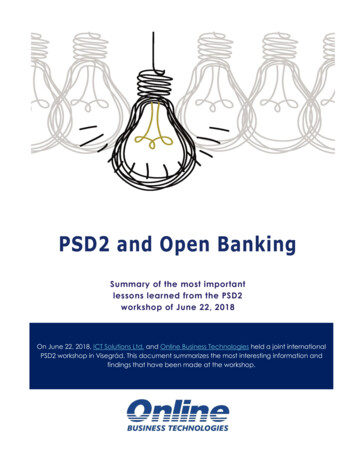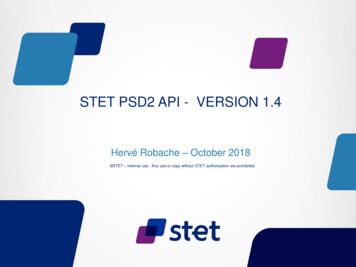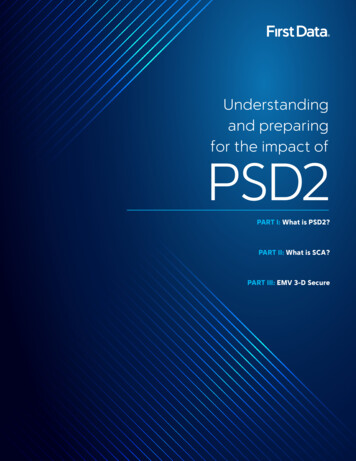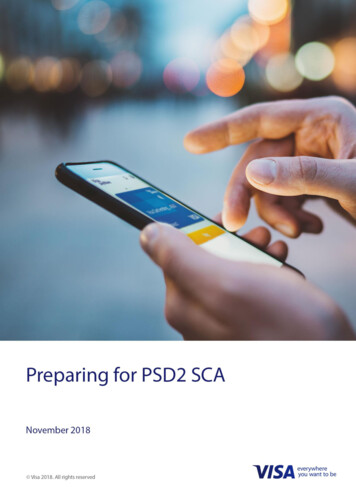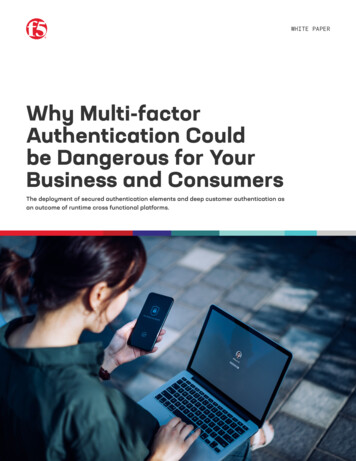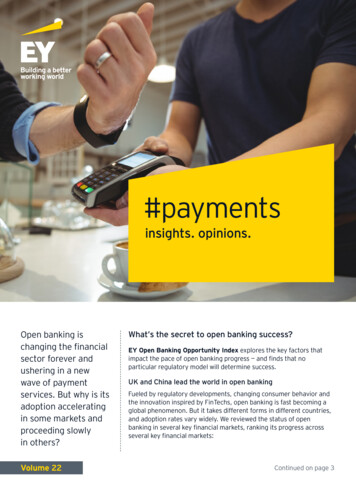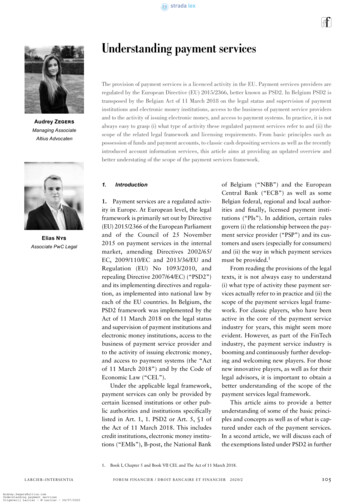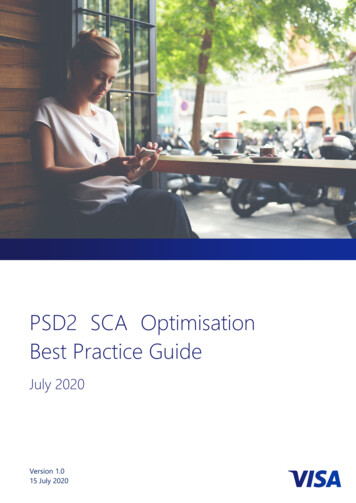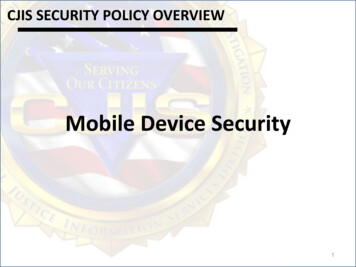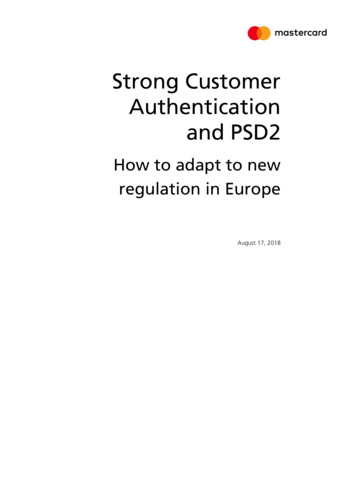
Transcription
Strong CustomerAuthenticationand PSD2How to adapt to newregulation in EuropeAugust 17, 2018
1.INTRODUCTION32. WHAT IS MASTERCARD’S AUTHENTICATION STRATEGY INEUROPE?3SEAMLESS SCA FOR HIGHER CONVERSION AND APPROVAL RATESRISK-SCORING FOR SECURITY AND ONE-CLICK PAYMENTSRULES CHANGES TO FACILITATE USE OF EXEMPTIONSFINALIZATION OF MASTERCARD’S AUTHENTICATION INFRASTRUCTUREPUBLICATION OF SAFETY & SECURITY ANNOUNCEMENTS345663.6THE NEW REGULATORY REQUIREMENTS FOR SCAWHAT IS SCA?WHAT IS DYNAMIC LINKING?WHEN WILL SCA APPLY?IS SCA REQUIRED FOR MERCHANT INITIATED TRANSACTIONS?WHICH TRANSACTIONS ARE EXEMPTED FROM SCA?WHITE-LISTS OF TRUSTED BENEFICIARIES. WHAT IS WHITE LISTING?WHAT IS THE TRA EXEMPTION?HOW ARE RECURRING TRANSACTIONS IMPACTED?CARD ON FILE MERCHANTS. ARE THERE EXEMPTIONS AVAILABLE?HOW DOES THE EXEMPTION FOR LOW-VALUE REMOTE PAYMENTS WORK?WHAT IS THE IMPACT ON CONTACTLESS PAYMENTS?WHICH EXEMPTION WILL COMMERCIAL CARDS BENEFIT FROM?WHAT IS THE EXEMPTION APPLICABLE TO UNATTENDED TERMINALS FOR TRANSITAND PARKING?WHAT IS TRANSACTION MONITORING?IS CARD DATA A VALID AUTHENTICATION FACTOR?IS DELEGATED AUTHENTICATION TO A SMARTPHONE ALLOWED?IS DELEGATED AUTHENTICATION TO A MERCHANT ALLOWED?IS PERSISTENT AUTHENTICATION FOR WEARABLE DEVICES ALLOWED?IS BEHAVIOURAL BIOMETRICS ALLOWED?HOW WILL THE EXEMPTIONS’ EURO LIMITS APPLY FOR TRANSACTIONS IN 4WHAT ARE THE KEY DECISIONS I NEED TO MAKE AS AN ISSUER? 14BIOMETRIC AUTHENTICATIONWHITE-LISTINGTRANSACTION RISK ANALYSIS (TRA) EXEMPTIONOTHER EXEMPTIONSCARD ON FILECVM DELEGATION1415161616165. WHAT ARE THE KEY DECISIONS THAT I SHOULD MAKE AS ANACQUIRER?16WHITE-LISTINGRISK-SCORINGTRA EXEMPTIONCARD ON FILE161617176.17CONCLUSIONSPage 2 of 17
1.IntroductionNew regulatory requirements will make authentication a key focus forcustomers in Europe. The new requirements are set out in the Revised PaymentServices Directive (PSD2) and in the Regulatory Technical Standards on SCAand Common and Secure Communication under PSD2 (RTS), which theEuropean Commission published on November 27, 2017.One of the key aims of PSD2 is to reduce fraud. To this end, PSD2 requiresstrong customer authentication (SCA) for electronic payments. The RTS set outthe SCA requirements and exemptions. The EBA has also published an Opinionon the implementation of the RTS (Opinion) to clarify the RTS.While past regulation (EBA Guidelines on the security of internet payments)covered only browser-based payments, the RTS also apply to in-app and faceto-face payments, regardless of device (e.g., desktop, mobile, wearable devicesand Internet of Things).The new requirements will apply from September 14, 2019 in all Member Statesof the European Union.2.What is Mastercard’s authentication strategyin Europe?The focus for Mastercard, its customers and all the players in the paymentecosystem should be on providing secure, simple and seamless cardholderexperiences that balance the new requirements against the friction ofauthentication.Mastercard’s objectives are:1) To drive e-commerce conversion and approval rates up.This can be achieved with a seamless authentication experience andbiometrics.2) To increase security.This can be achieved with effective risk-scoring, which provides alayered approach to security and allows for one-click payments.3) To help customers apply the exemptions.This can be achieved with changes in our rules that facilitate theapplication of the exemptions.Seamless SCA for higher conversion and approval ratesSCA is effective if used with a best in class consumer experience. A seamlessauthentication solution through any device, any merchant and any cardholder iskey. This will drive e-commerce conversion and approval rates up and increasetransaction volumes.Page 3 of 17
Mastercard Identity Check provides such a seamless authentication experienceacross payment environments and devices (face-to-face and e-commerce, inapp and within websites, Internet of Things). Mastercard Identity Checkimplements the EMV 3DS (3DS v2) global industry standard for authentication.With biometrics, Mastercard Identity Check allows cardholders to securely paywith one single touch. This will drive e-commerce approval rates to the levelof face-to-face or even higher. Mastercard has developed other biometricssolutions that provide a seamless consumer experience (e.g., Masterpass andDSRP).Mastercard mandates that Issuers offer their customers biometric authenticationfor Mastercard Identity Check/SecureCode and Masterpass transactions,including NFC mobile transactions. Issuers must offer an alternativeauthentication method for cardholders without a smartphone (e.g., an OTP viaSMS).SCA must be based over time on non-static authentication (see Security Bulletinon Identity Check published in October 2016). Mastercard Identity CheckProgram bans static passwords and static PIN in online environments.Risk-scoring for security and one-click paymentsMastercard’s authentication strategy consists of a layered approach. Bylayering security approaches, such as effective risk-scoring, alongside an actualauthentication, much greater security can be obtained. This layered approach(or defence in depth) provides much greater protection for all parties than thereliance on a single-layered approach, no matter how strong that approach orauthentication may be.Risk-scoring takes advantage of information that is available at or beforeauthentication and during authorization. The use of device information, geo orIP location, behavioural biometrics, and scoring using Artificial Intelligenceprovide a wealth of opportunities to determine the risk associated with atransaction.The regulation mandates risk-scoring for each transaction. If the risk is low andan exemption applies, SCA is not required. This makes one-click payments stillpossible under the new regulation.In order to achieve a complete risk-scoring, the best solution is for the merchantto provide the Issuer with information about the transaction, including its ownrisk-scoring. In this way, the Issuer may assess the risk of a transaction and, ifthe risk is low and an exemption applies, decide not to apply SCA. Merchantscan also provide this information to the Acquirer to enable the Acquirer to applyan exemption. The Opinion confirms that Acquirers may outsource their riskscoring to merchants.Page 4 of 17
In the Mastercard network, Acquirers will not be liable for fraudulenttransactions when merchants initiate an authentication request using EMV 3DS(Mastercard Identity Check). However, if the Acquirer applies an exemption,the Acquirer will be liable. Mastercard is requiring that merchants supportEMV 3DS (or an alternative technological solution) in all European countries.Mastercard will provide risk-scoring solutions that may be helpful forcustomers. The solutions will be particularly useful for those customers thatintend to apply an exemption. Customers will find more information aboutMastercard risk-scoring solutions in an upcoming announcement.Mastercard will also offer packaged solutions that will significantly ease theburden of compliance and reduce the impact on in-house IT development.These solutions group together a number of existing Mastercard hostedproducts.Rules changes to facilitate use of exemptionsThe exemptions bring significant benefits as they allow for one-click payments.Mastercard encourages its customers to apply all the exemptions. Mastercardis changing its Rules to facilitate the application of the exemptions.The white-listing exemption is important especially for card-on-file (CoF)payments. The Issuer’s Masterpass wallet and the Issuer’s ACS provider arebest placed to support white-listing of merchants on the Issuer’s behalf.Mastercard recommends that Issuers ensure their Masterpass wallet and ACSproviders support white-listing of merchants. Issuers and Acquirers areencouraged to explain to cardholders and merchants the benefits of whitelisting.The Transaction Risk Analysis (TRA) exemption is allowed under certain fraudlevels and transaction amounts. This exemption is based on the concept of RiskBased Authentication (RBA). RBA is a process where the Issuer (or theAcquirer) evaluates the fraud risk of a transaction and SCA is not applied if therisk is low. Before the RTS apply in September 2019, Mastercard recommendsthe use of RBA. Once the RTS apply, Issuers and Acquirers are encouraged toapply the TRA exemption, provided their fraud rate is below the reference fraudrate and the transaction amount is below the Exemption Threshold Value, asdefined in the RTS.In order for all customers to benefit from the TRA exemption, Mastercard willprovide guidelines on how best Acquirers should apply this exemption.Liability will be shifted to Acquirers when they apply the TRA exemption.Page 5 of 17
Finalization of Mastercard’s authentication infrastructureMastercard is completing the development of the infrastructure to support thenew authentication requirements. Support for customers is already planned andbeing communicated through bulletins.Mastercard has changed its e-commerce consumer-facing authentication brandfrom Mastercard SecureCode to Mastercard Identity Check. The new brandbetter reflects our new authentication solution, with its emphasis on biometricsand ban on static authentication.Mastercard is also developing innovative authentication solutions based onbehavioural biometrics.Publication of Safety & Security AnnouncementsMastercard has decided to change its Rules to help our customer provide a betterauthentication experience and facilitate the use of exemptions in Europe. Thesechanges are published in our Safety & Security Announcements. Mastercardwill publish further Announcements in its aim to help customers comply withthe regulation.3.The new regulatory requirements for SCAThe following is a list of questions regarding the new regulatory requirements.The answers are provided to the best of our knowledge and do not constitutelegal advice. Customers are encouraged to speak with their legal counsel forguidance.On June 22, 2018, the EBA activated an online Q&A tool through whichstakeholders may submit questions on the RTS. Mastercard has alreadysubmitted 26 questions.What is SCA?The RTS define SCA as authentication through at least two out of the followingthree factors: Something only the user knows (e.g., passcode or PIN);Something only the user possesses (e.g., mobile phone or token);Something the user is (e.g., fingerprint, facial, iris or eye vein).The RTS require that the selected factors must be mutually independent in thatthe breach of one does not compromise the reliability of the other (Article 9RTS). The Opinion clarifies that the authentication factors must belong todifferent categories.Page 6 of 17
The use of a single device for authentication and shopping is expresslypermitted. This means, for example, that a smartphone may be used at the sametime for transacting and for authenticating the cardholder. The risk connectedto the use of multi-purpose devices (e.g. smartphones and tablets) must bemitigated through the use of separated secure execution environments.Mechanisms to ensure that the software or device have not been altered by thepayee or by a third party must be in place, as well as mechanisms to mitigatethe consequences of such alteration.What is dynamic linking?For remote transactions, each SCA must be linked to a specific amount andpayee (dynamic linking). This requirement, effectively binding authenticationto the merchant and the amount, aims at ensuring that a valid authenticationcode is only used once and for the specific transaction for which theauthentication is requested (Article 5 RTS). This aims to reduce “man in themiddle” attacks.The dynamic linking requirements can be summarized as follows:– The cardholder must be made aware of the merchant details andamount when asked by the Issuer to authenticate.– The authentication code generated by the Issuer can only be usedonce and must be linked to the specific merchant and amountdisplayed to the cardholder.– The authentication code must successfully authenticate only thetransaction linked to those specific merchant and amount.– The resulting cryptographic token must be passed by theAcquirer in the authorisation request and must be unique for thatspecific transaction.– The Issuer must validate the cryptographic token passed inauthorisation and ensure that there is a match in merchant andamount between the token and authorisation (or that thetransaction authenticated is the same as the transactionauthorized).When will SCA apply?SCA is required when the payer initiates an electronic payment transaction. Theregulation also mandates SCA for any action through a remote channel that mayimply a risk of fraud (e.g., initial registration of a card in a wallet or in a Cardon File solution).Conversely, SCA is not required for Mail & Telephone order (MoTo),anonymous prepaid and direct debit transactions.Page 7 of 17
Is SCA required for Merchant Initiated Transactions?The RTS do not clarify whether card transactions initiated by the payee only(so-called ‘Merchant Initiated Transactions’ or ‘MITs’) are subject to SCA.MITs include a variety of use cases, such as utilities bill payments, pay-TV andmobile phone subscriptions, car/bike sharing transactions, digital servicessubscriptions, insurance premium payments, hotel charges and fundingtransactions for staged wallets.Mastercard believes that MITs are excluded from the application of the SCArequirements, insofar as: There is a pre-existing agreement between the cardholder and themerchant for the provision of products or services. The cardholder has given a mandate to the merchant to initiate theperiodic payments. This initial mandate requires SCA. The cardholder is technically unable to authenticate the payment and isnot involved in initiating the transaction.Mastercard is liaising with the EBA and national competent authoritiesexplaining why MITs are excluded from the application of the SCArequirements.Which transactions are exempted from SCA?While SCA is the rule for electronic transactions, the use of alternativeauthentication measures is permitted if an exemption applies. The use ofexemptions remains optional and is not mandatory. The following tablecontains a list of the exemptions that are discussed in this document:White list of trusted beneficiariesTransaction Risk Analysis (TRA)Recurring transactionsLow-value remote transactionsContactless paymentsCommercial transactionsUnattended terminals for transit and parkingArticle 13 RTSArticle 18 RTSArticle 14 RTSArticle 16 RTSArticle 11 RTSArticle 17 RTSArticle 12 RTSWhite-lists of trusted beneficiaries. What is whitelisting?Cards benefit from the white-listing exemption (Article 13 RTS). The Opinionhas expressly confirmed this. The cardholder can request the Issuer to whitelist a merchant so that SCA is not required on subsequent transactions to thatmerchant. Issuer must apply SCA when the cardholder adds, deletes or amendswhite-listed merchants.Issuers can develop their apps and banking website to allow white-listing forcards. ACS providers can play an important role by requesting the cardholderPage 8 of 17
to white-list a trusted merchant while shopping. For example, the cardholdercould tick a box to white-list the merchant when authenticating the transaction.One single SCA may be sufficient for authenticating the transaction andsimultaneously white-listing the merchant.White-listing is important to enable one-click payments, especially for CoFpayments. For these transactions, one SCA for registering the CoF andsimultaneous white-listing of the merchant may be sufficient.Mastercard is finalizing its Standards for Merchant White-Listing (MWL),which will be issued shortly.What is the TRA exemption?This exemption is particularly suited to allow customers to balance the need forSCA against friction at checkout. It applies only to remote payments. Stringentconditions are provided for the application of this exemption (Article 18 RTS).Merchants cannot apply this exemption directly but can rely on their Acquirerapplying the exemption. If the Acquirer applies the exemption, it will be liablefor the transaction.To take advantage of the TRA exemption, the customer that is applying theexemption must enjoy a gross fraud level up to 13bps in a quarter. The actualfraud level determines the maximum exempted transaction value (ETV), as perthe table below:ETVEUR 500EUR 250EUR 100Reference fraud rate (bps)1613The formula to calculate the reference fraud rate for the application of the TRAexemption is total value of unauthorized and fraudulent remote card transactionsdivided by total value of all remote card transactions.The following should be noted: All remote card transactions should be considered for the calculationregardless of whether (1) they are subject to SCA or (2) they fall underan exemption. Face-to-face transactions are excluded from the calculation of the fraudrates. The total value of unauthorised/fraudulent remote transactions should begross, i.e. regardless of whether the funds have been recovered or not.Thus, chargebacks should not be included. Fraudulent transactions resulting from the payer being manipulated mustbe included in the calculation of fraud rates.Page 9 of 17
Fraud rates cannot be calculated at the level of the individual merchantor channel (app/web).Customers should calculate the fraud rate across all values and thenchoose the Exempted Threshold Value (ETV) band that is allowed.Transactions above the ETV for which a customer qualifies, and anytransaction over 500, must be undertaken with SCA (unless anotherexemption applies).The customer that is applying the exemption will have to maintain or improveon its fraud levels. If the customer exceeds 13bps of fraud in two consecutivequarters, the customer must immediately cease to use the exemption (Article 20RTS). Evidence will need to be provided that rates have been maintained belowthat rate for an entire quarter before the customer will be eligible to use thisexemption again. The customer must have its fraud data audited and, uponrequest, make the audit available to its national competent authority.How are recurring transactions impacted?An exemption applies for recurring transactions with the same amount and withthe same payee (Article 14 RTS). This means that a series of recurringtransactions to the same merchant is exempted provided the amount isunchanged (e.g., a monthly payment for the same amount). The first transactionof the series must always be undertaken with SCA. Mastercard will clarify inits Rules how to flag these transactions.As explained above, Mastercard believes that the SCA requirements do notapply to Merchant Initiated Transactions.Card on File merchants. Are there exemptionsavailable?Card on File (CoF) merchants provide a better consumer experience at checkout. The merchant offers the shopper to store her/his card details, such as PANand addresses, so that this information does not have to be keyed in on everyoccasion the cardholder initiates a payment.The RTS do not contain a specific exemption for CoF transactions. SCA isrequired on every CoF transaction where the cardholder is triggering eachindividual payment (except if an exemption applies). White-listing isparticularly relevant to allow for one-click payments with CoF.As explained above, Mastercard believes that the SCA requirements do notapply to Merchant Initiated Transactions.Page 10 of 17
How does the exemption for low-value remote paymentswork?This exemption applies to remote transactions up to 30, with a maximum of 100 cumulative spend or 5 consecutive transactions since SCA was last applied(Article 16 RTS).The Issuer is allowed to choose which counter (cumulative limit or number oftransactions limit) to apply. The Opinion confirms this.What is the impact on contactless payments?Contactless payments provide convenience to cardholders and reduce cashusage. Exemptions are provided for low-value contactless transactions (LVTs)up to 50 with a maximum of 150 cumulative spend or 5 consecutivetransactions (Article 11 RTS).This means that if 150 (cumulative) worth of contactless transactions are madeat a point of sale or 5 transactions below the contactless no-CVM limit are made,then the terminal would need to ask for SCA to be applied for the nexttransaction (even if that transaction would qualify as a no-CVM transaction).The Issuer is allowed to choose which counter (cumulative limit or number oftransactions limit) to apply. The Opinion confirms this.The regulation does not clarify how the exemption for contactless LVTs mustbe managed when a PAN is digitized in one or more devices. In this case, it isnot clear whether the exemption should be managed at the account level (takinginto account all contactless transactions for a specific account across all devices)or at the device level (taking into account only the contactless transactions foreach individual device). Mastercard asked the EBA for confirmation that theexemption may be applied at device level, as this would require a less complextechnical implementation.Which exemption will commercial cards benefit from?Business-to-business payments over dedicated payment processes and protocolsare exempted. This exemption will apply to “payment processes or protocolsthat are only made available to payers who are not consumers where competentauthorities are satisfied that those processes or protocols guarantee at leastequivalent levels of security” to those achievable with SCA (Article 17 RTS).Although this leaves the decision with the competent authority of each MemberState, we believe that the following examples of commercial transactions shouldbe exempt:Lodged cards: A commercial card that is lodged with a company-approved thirdparty, such as a travel company that books travel and hotels on behalf of thecompany by secure dedicated payment process and protocol, is exempted. UsePage 11 of 17
cases include both traditional company travel procurement (via a companyapproved travel agency) and broader business-to-business procurement, wherecommercial cards are lodged securely directly with approved companysuppliers.Use of a commercial card by an employee him/herself at a public website forthe purchase of equivalent goods or services (such as travel or accommodation)is instead not exempted as this transaction does not use a secure dedicatedpayment process and protocol.Virtual Card Numbers: Virtual card numbers (VCNs) used over dedicatedpayment processes and protocols ensure a very high level of security. Thegeneration of VCNs is protected with SCA and the virtual PAN itself can alsobe uniquely linked to the merchant or other parameters that further control itsuse (e.g. amount, time). SCA at the time of use is therefore not required.What is the exemption applicable to unattendedterminals for transit and parking?SCA is not required for (contact and contactless) transactions for paying atransport fare or a parking fee at unattended payment terminals, regardless ofamount (Article 12 RTS). Thus, this is not a general exemption for allunattended terminals.The Opinion clarifies that the exemptions are separate and independent fromone another. This means, for example, that a transaction for which SCA wasnot applied in application of the exemption for transactions at unattendedterminals for transit and parking will not count towards the limits of thecontactless exemption.What is Transaction Monitoring?The regulation mandates Transaction Monitoring for all transactions (Article 2RTS). Transaction Monitoring is based on transaction information and allowsbuilding a risk score for each transaction. Transaction Monitoring and itsassociated risk scoring add value in both authentication and authorization asthey indicate the risk of the transaction. If risk scoring indicates that thetransaction is risky, such transactions should be declined in authorization, evenwhen fully authenticated. An enhanced form of Transaction Monitoring ismandated for the application of the TRA exemption.Is card data a valid authentication factor?The Opinion holds that card data (PAN, cardholder’s name, expiration date,CVC) is not a valid authentication factor. This is because card data is not‘something only the user knows’.Mastercard instead believes that the combination of (1) card data (2) EMV3DS behaviour-based information (3) an OTP (e.g. a SMS OTP) qualifies asPage 12 of 17
SCA and is compliant with the RTS. Mastercard is liaising with the EBA andnational competent authorities to explain why this authentication solution iscompliant with the SCA requirements.Mastercard believes that tokenized card data is also a valid authentication factor.When associated univocally with a device, the token cannot be used fromanother device. This makes the token an ownership factor.Is delegated authentication to a smartphone allowed?There are a number of devices (e.g. smartphones) that include a ConsumerDevice Cardholder Verification Method (CDCVM) to access the device. Thisis a great opportunity for these devices to be used by consumers to authenticatethemselves for a payment, especially for mobile NFC payments, as most of themoccur via x-Pay wallets (e.g., Apple Pay).Issuers are allowed to rely on the CDCVM to authenticate their cardholders,provided Issuers always securely associate the device (and its CDCVM) byapplying SCA for the initial enrolment of a card in the wallet (or x-Pay wallet).Mastercard is setting network security standards of a shared CVM, whichexamines both the types of CVM in use (biometrics, swipe patter, PIN etc.) andthe technical requirements for the device to be securely used for authentication.The Opinion confirms that SCA delegation is allowed.Is delegated authentication to a merchant allowed?Issuers are allowed to rely on the security credentials issued by the merchant toauthenticate cardholders, provided the security credentials are compliant withthe SCA requirements under the RTS (for example, they allow for securebiometric authentication). This would require SCA by the Issuer for theassociation with the cardholder of the credentials issued by the merchant and anexpress delegation by the Issuer. In addition, it would only be allowed for lowrisk merchants and provided the card is digitized and tokenized in the CoFsolution of the merchant. This could be managed through a Mastercard program(e.g., ‘Express’, which currently regulates Issuers’ participation to the x-Paywallets through MDES). Merchants could bear liability for these transactions,if permitted by national competent authorities.Is persistent authentication for wearable devicesallowed?Persistent authentication means that authentication occurs continuouslythroughout the cardholder’s operation of a wearable device, typically throughcontinual contact with human body or biometric monitoring (for example, themonitoring of a heartbeat). The RTS are technologically neutral and do notexpressly regulate wearable devices. We believe that they are compliant withthe RTS provided that they continuously apply SCA (e.g. through a token in thewearable device associated with SCA by the Issuer or sufficiently secure unlockPage 13 of 17
mechanism). The dynamic linking requirement does not apply to face-to-facetransactions with wearable devices.Is behavioural biometrics allowed?The Opinion confirms that behavioural biometrics is allowed as a validinherence factor under the RTS.Issuers will remain responsible for determining if it is appropriate to selectbehavior-based biometrics information as a valid inherence authenticationelement in itself or as support for the risk analysis and monitoring associatedwith a transaction under the RTS. This decision will have regard for the riskprofile of the transaction, the information transmitted through EMV 3DS andthe reliability of the behavior-based information obtained (in terms ofminimizing false positives and the chances of replication).How will the exemptions’ Euro limits apply fortransactions in other currencies?The RTS set out transaction amount limits for the application of the TRAexemption and the exemptions for low-value remote payments and contactlesstransactions. The RTS express these limits only in Euro. For transactions innon-euro currencies, national competent authorities or national acts may set anational currency equivalent. Where this does not occur, card schemes andcustomers may set a (rounded) currency equivalent.What are the key decisions I need to make asan Issuer?4.Biometric AuthenticationMastercard believes that biometrics will play an important role inauthentication. Cardholders find biometrics increasingly familiar thanks tosmartphone penetration. Smartphones increasingly use some form ofbiometrics, fingerprint and facial recognition to unlock the device. Devicemanufacturers have been training consumers to accept this as normal practice.Some customers have already taken steps to deploy this technology. Whenbiometric authentication is used, Issuers report that abandonment rates typicallydrop by 70% compared to other methods (e.g., an OTP sent via SMS). Thisreflects the much-improved user experience.In order to guarantee security and reduce friction at checkout, Issuers shouldoffer biometric authentication. To this end, Issuers will have to: Ensure that biometric authentication methods meet industry standards,e.g. NIST SP800-63-3 (see https://pages.nist.gov/800-63-3/).Page 14 of 17
Ensure that cardholders are authenticated via a single mobile applicationto avoid separate authentication processes for different transactiontypes. A single authentication experience is key for cardholders. TheIssuer’s mobile banking application should embed payment andauthentication functionalities and provide the same biometricauthentication user experience for c
covered only browser-based payments, the RTS also apply to in-app and face-to-face payments, regardless of device (e.g., desktop, mobile, wearable devices and Internet of Things). The new requirements will apply from September 14, 2019 in all Member States of the European Union. 2. What is Mastercard's authentication strategy in Europe?
